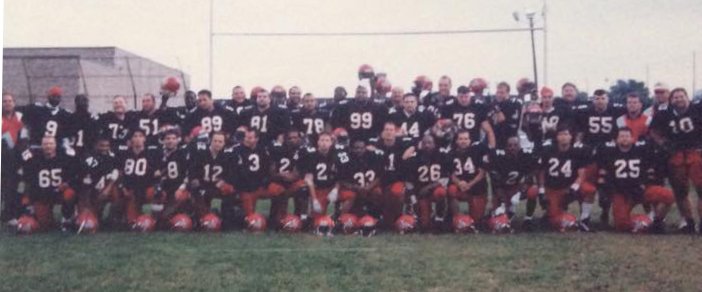The NEFL was founded in 1994 by League President and Director of Marketing, Tom Torrisi, Chairman Matt Brien, Commissioner Bob Oreal, Vice-President and Treasurer John Motta and Secretary Christine Torrisi. In its inaugural season, the league consisted of only four teams, the Lawrence Lightning, the Greater Lawrence Grizzlies, the Rockingham Reapers and the Haverhill Rage. All the games were played on one practice field and each team had only between 22 – 25 players on their roster. The first year, however, was a success because the league was built on a solid foundation. Each team had sponsorship from local area businesses and the league had adopted a stringent set of rules, regulations and bylaws that kept everything on and off the field highly organized. All game officials were certified Eastern Massachusetts high school officials and all rules were strictly enforced right down to the uniform rule. It was these things that gave the NEFL credibility and allowed for media coverage by local newspapers. The Lawrence Lightning became the league’s first champions by defeating the Haverhill Rage.
In 1995, the NEFL expanded by two teams, the Bay State Bulldogs, another team representing the Greater Lawrence area and the Boston Bandits from Greater Boston. The league now had its first team from outside of the Merrimack Valley. The Lawrence Lightning moved to Methuen to become the Essex County Sharks, the Rockingham Reapers changed their name to the Cougars, and the Haverhill Rage relocated to Hampton, New Hampshire to become the Seacoast Rage. The league also joined the AFA and each team’s roster grew to between 30 – 35 players. The league also signed its first radio contract and had the NEFL game of the week broadcast each Monday night on WCCM radio in Lawrence. The second year had been even more successful than anyone had hoped and the Seacoast Rage defeated the Rockingham Cougars to become champions of the NEFL for 1995.

The 1996 campaign saw the NEFL undertake its largest expansion to date. The Merrimack Valley Vipers, the Middlesex County Seminoles, the Eastern Mass Mavericks, the Massachusetts Havoc and the Southern Maine Spartans became the five newest members of the league. The Greater Lawrence Grizzlies folded after the 1995 season. The NEFL now had ten teams with a Northern and Southern division. Four of the five new teams were successful and made the playoffs. It was the Massachusetts Havoc, however, that took home the NEFL championship by upsetting the previously undefeated Eastern Mass Mavericks and end a third successful year for the league.
Three more new teams entered the NEFL in 1997. The Rhode Island
Rhinos, the South Shore Stars and the Greater Haverhill
Highlanders were added which made for a strong and competitive
twelve team league. The Southern Maine Spartans left the NEFL in
1997 to join the new Maine State Football League. The NEFL
expanded the rosters to 40 players to accommodate the growing
interest.
For the first time, the league would have a two time winner. The
Seacoast Rage, winners of the NEFL Northern Division, playing in
their third championship game, would be going against the
defending champion, Massachusetts Havoc, winners of the NEFL
Southern Division. The Massachusetts Havoc became the first team
in league history to not only win two championships but win them
back to back. The Havoc then went on to become the first ever
winners of the North Atlantic Football Federation in the inaugural
Harvest Bowl when they defeated the Central Maine Storm of the
Maine State Football League.
The 1998 season opened with the Greater Lowell Nor’easter
replacing the defunct Seacoast Rage and the Rhode Island Gridiron
taking the place of the Merrimack Valley Vipers, who took a one
year leave of absence to reorganize.
1998 was another exciting and successful season for the NEFL. The
Greater Lowell Nor’easter, Northern Division Champions, defeated
the Southern Division Champion Tri-boro Rhinos to win the NEFL
championship. The Nor’easter then went on to defeat the Central
Maine Storm of the Maine State Football League in the first round
of the N.A.F.F. playoffs. The Irondquoit Sting, champions of the
New York Football League (NYFL) traveled to Massachusetts to play
the Nor’easter for the second annual N.A.F.F. double AA national
championship Harvest Bowl. Greater Lowell defeated Irondquoit and
became the NEFL’s second national champion in two years.
The 1999 season saw the return of the former Merrimack Valley
Vipers to the league as the Lawrence Lightning, and the Essex
County Sharks merged with the Greater Haverhill Highlanders.
Although the Rhode Island Gridiron and Middlesex County Seminoles
folded due to financial problems, the Quincy Granite became the
newest members of the NEFL and were tremendously successful,
finishing second behind the Massachusetts Havoc in the southern
division. Each team’s roster limit was increased to fifty players
in 1999 due to greater participation.
The Greater Lowell Nor’easter won their second straight NEFL title
by defeating the Massachusetts Havoc in a championship game that
featured two of the top AA teams in New England. The Nor’easter
then defeated the Buffalo Gladiators, title winners of the New
York Amateur Football League (NYAFL), for their second straight AA
national title in the annual Harvest Bowl.
Minor League Football News also named the New England Football
League “AA League of the Year” in 1999 and awarded it with the
privilege of hosting the annual “Free Agent Scouting Combine
All-Star Game” in 2000. This game featured the best National Minor
League All-Stars in the United States playing the New England
Football League All-Stars on, May 20 at Cawley Stadium in Lowell,
Massachusetts. The game was an overwhelming success with the NEFL
All-Stars defeating the National Minor League All-Stars.